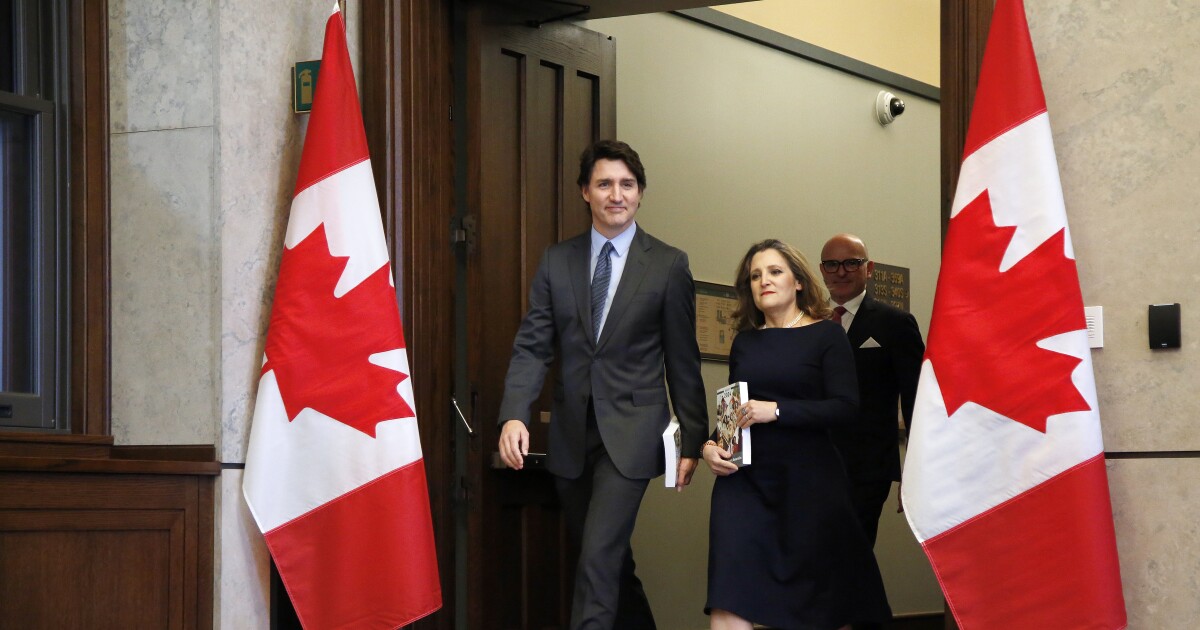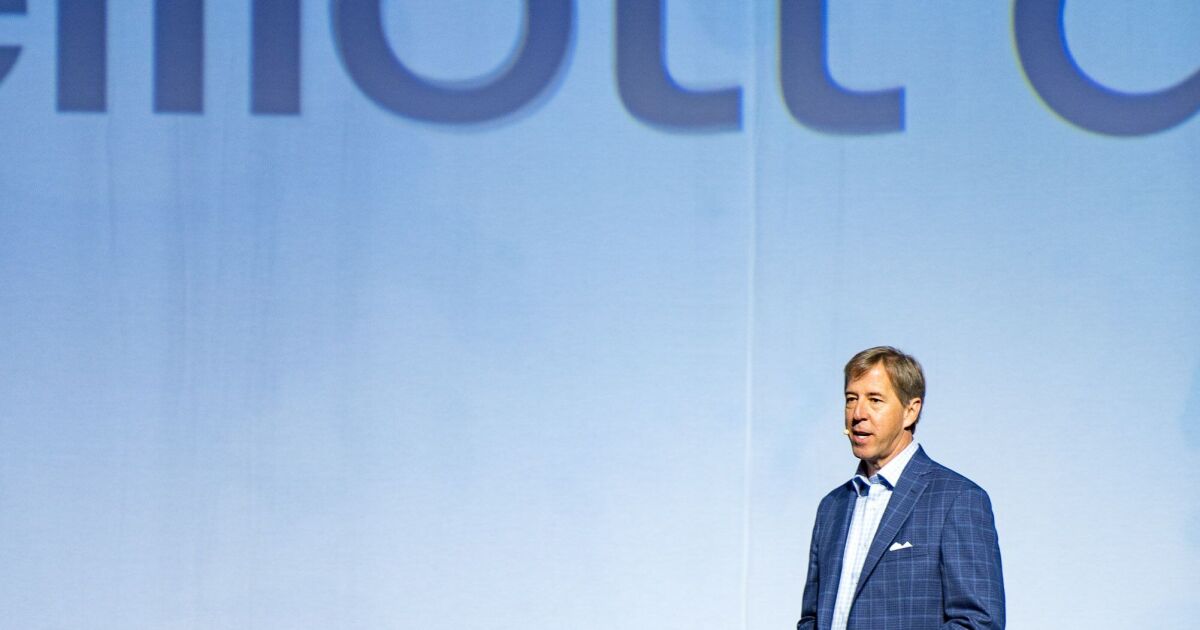Donald Trump’s planned tax cuts would wipe out Canada’s slim corporate tax advantage, likely driving more capital from the northern nation and deepening its productivity crisis.
Canada’s federal corporate income tax rate is 15%, compared with 21% in the U.S. After accounting for provincial and state levies, the two countries are similar, with the corporate rate between 25% and 27% in Canada and about 26% to 27% in the U.S., said John Oakey, vice president of taxation with Chartered Professional Accountants Canada.
Trump has proposed slashing the U.S. corporate rate to 15%. He’s also pledged to extend his 2017 tax cuts, many of which are due to expire by the end of 2025, including individual income tax reductions. While he may face hurdles in Congress, the Republican sweep of both chambers makes it more likely he’ll pull off his agenda.
His election “turns the heat up” on Canadian policymakers, said William Robson, chief executive officer of the C.D. Howe Institute, as the country “ought to be reducing the taxes that are the most punishing on entrepreneurial activity and investment.” That includes taxes on businesses and high earners.
“We need to break the glass on our tax competitiveness problem,” he said.
Justin Trudeau, Canada’s prime minister, and Chrystia Freeland, Canada’s finance minister.
Canada’s Finance Minister Chrystia Freeland estimated earlier this year that the tax rate on new business investment would rise to 16.8% by 2028, more than eight points lower than a projected 24.9% in the US. Trump’s election upends that expectation. And her government’s decision to raise the capital gains inclusion rate in June to “make Canada’s tax system fairer” drew the ire of many economists and businesses.
Under Prime Minister Justin Trudeau, fiscal policy has been geared toward redistribution and has recently involved new spending on housing, daycare, dental and drug plans. That’s increasingly been funded by corporate taxes, which represented 21% of the federal government’s revenues in fiscal year 2022-23 — the highest in data going back to 1966.
“Directionally, it’s becoming more clear that the US is going in one direction and Canada’s going the other,” Oakey said.
Trump’s tariff threats aside, Canada is at a disadvantage to the U.S. The world’s biggest economy has more than eight times Canada’s population. The U.S. also spends more on research and development as a percentage of its economy — 3.6% in 2022, versus 1.8% for Canada.
When Trump began slashing business taxes in 2017, Trudeau’s government responded by allowing Canadian firms to write off certain assets more quickly, including machinery and equipment. Those tax breaks are set to end this year.
A top priority should be keeping those breaks as part of a “major shift” in Canada’s tax system, said economist Jack Mintz, president’s fellow in the school of public policy at the University of Calgary. The Business Council of Canada also recommended “a comprehensive review of the tax system to better incentivize private sector investments and boost wages” in a report from September.
Mintz suggested reducing the country’s top personal tax rates, which are above 50% in most jurisdictions and kick in at lower incomes than in other Group of Seven countries such as France and Japan. Lost revenue could be recouped as businesses expand production or new firms are created, he said.
The country’s parliamentary budget officer, Yves Giroux, has argued that Canada has the space for tax cuts.
Brain drain
High taxes add fuel to concerns about Canada’s productivity problem, which the country’s central bank declared an “emergency” in March and attributed to limited capital investment. These conditions are prompting some entrepreneurs to consider moving elsewhere.
That so-called brain drain has been a longstanding issue. Tech founders often point to Slack Technologies Inc., which originated in Vancouver but set up in San Francisco before being acquired by Salesforce in 2021 for $27.7 billion.
An artificial intelligence chip startup called Tenstorrent founded in Toronto — valued this month at $2.7 billion — quietly re-domiciled to Santa Clara, California, at the end of 2023, according to tech publication The Logic.
Others may follow suit.
“Almost every day we’re talking about whether, for our own scale plans, it makes sense to stay in Canada or whether the move is to go to the United States in 2025,” said Herman Chandi, co-founder of UrbanLogiq, a Vancouver-based startup that sells data analytics to governments.
Chandi said he’s mulling factors such as Trump’s tax agenda, the increase to Canada’s capital gains inclusion rate, “Buy American” procurement policies, the cost of living in Vancouver and anemic economic growth in Canada. His company’s investors may also require UrbanLogiq to move to the US, “and so those conversations are ongoing.”
Tax advisors have also had conversations like these.
“Anecdotally, I’ve heard from lots of professionals who have packed up and left or have at least said they’re considering leaving,” Oakey said.
Kenneth Keung, a tax advisor with Moodys Tax in Calgary, said he’s also seeing a ramp up in wealthy clients, including manufacturers, asking for guidance on how they can move their businesses and assets to the U.S. since Trump’s election.
Conservative Leader Pierre Poilievre, whose party holds a substantial polling lead over the incumbent Liberals, has pledged to cut taxes and regulations for businesses, though he’s not specified how low taxes would go.
“Rampant tax increases by the Trudeau NDP-Liberal government have pushed money out of our country,” Poilievre said in a radio interview with CKNW in Vancouver last month, referring to a power-sharing deal the Liberals had with the left-wing New Democratic Party. He said he would eliminate the carbon tax, cut income tax and cut taxes on investment if elected.


 Personal Finance1 week ago
Personal Finance1 week ago
 Economics1 week ago
Economics1 week ago
 Economics5 days ago
Economics5 days ago
 Economics1 week ago
Economics1 week ago
 Economics5 days ago
Economics5 days ago
 Economics5 days ago
Economics5 days ago
 Economics3 days ago
Economics3 days ago
 Finance5 days ago
Finance5 days ago












